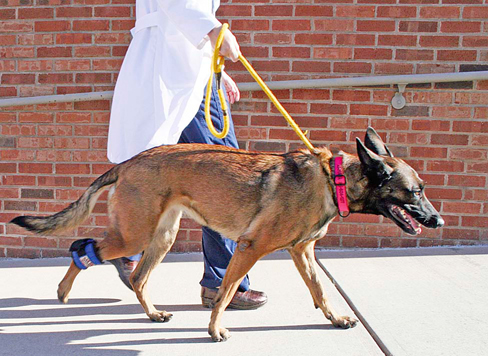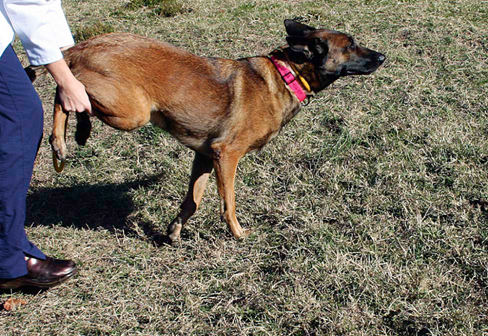Therapeutic exercises to improve active joint motion through a more complete range, and to build power, strength, and speed are the final phases of rehabilitation to return the patient to as normal a function as possible. The therapist must keep in mind the degree of injury or disability in determining the likelihood for the patient to reach higher levels of function and adjust the rehabilitation program and expectations accordingly. For example, it is not expected that a 7-year-old dog with severe bilateral elbow arthritis would be able to achieve near-normal function, but there are exercises that can be performed to help achieve greater function and ability. Some of the common goals of therapeutic exercise are to improve active pain-free range of motion (ROM), muscle mass and muscle strength, performance, and conditioning. Common activities include stair climbing, sit-to-stand exercises, treadmill activity with resistance, pulling or carrying weights, “wheelbarrowing” (for forelimb activity), “dancing” (for rear limb activity), walking and trotting across cavaletti rails, jogging, running, underwater treadmill activities, swimming, playing ball, and activities using balance balls or rolls. These higher levels of therapeutic exercise are important in assisting an animal’s return to the best function possible following early limb use and proprioceptive exercises. Many of the exercises that target certain aspects of performance, such as joint motion, conditioning, and strength, have some overlap (Box 30-1). In addition, the equipment needed for most exercises is relatively inexpensive, and similar principles apply to a variety of individuals and conditions. Therapeutic exercise programs designed for the home environment also provide an opportunity for owners to become actively involved in their pets’ rehabilitation. In any case, it is very important to have good footing to avoid slipping and to have adequate space to perform exercises with as little distraction as possible. It is also important to remember to use patience when working with the dog to learn new exercises. Most of the exercises in this chapter have been purposefully selected so that most dogs that are trained to leash can perform them with some basic training. However, some dogs are highly trained and the therapist should work with the owner to select exercises based on the patient’s needs, as well things the dog is already trained to perform. The therapist is cautioned to use training techniques that are based on positive reinforcement. Negative reinforcement techniques may temporarily work in some instances, but because rehabilitation is an ongoing treatment, dogs will become less willing to perform an activity or to learn new ones. Many dogs will be somewhat nervous or frightened when first undergoing rehabilitation, especially if pain is involved from their injury or surgery. It is important to go slowly and gently at the beginning. Treats, favorite toys, or other rewards should be kept handy to encourage dogs when learning new exercises. The reader is referred to Chapter 4 for further tips on applying behavior techniques in the rehabilitation environment. Therapeutic exercise routines should be monitored at regular intervals by a trained individual familiar with the patient and the exercise techniques. Inappropriate exercise or improper technique may result in inappropriate stresses, further injury, or exacerbation of an existing condition. Certain exercises may not be safe for the strength, flexibility, or endurance level of the animal performing the exercise, or an exercise may not be the correct one to accomplish the intended goal. The exercises described in this chapter are listed with the desired outcomes of joint motion, conditioning, or speed and strength, but there is significant overlap with some exercises, and the differences are indicated for the various outcomes. The reader is also referred to Chapter 24 on biomechanics of rehabilitation for further details on therapeutic exercises, especially as they relate to joint motion and forces. Walking the dog up an inclined surface alters joint motion and aids in strengthening of the hip and stifle muscles, especially the extensors, while ascending (Figure 30-1). Climbing up an inclined surface promotes increased flexion, extension, and ROM of the hip. Stifle flexion is decreased, however.1 When the limb is in the stance phase of gait and the body is traveling forward, the knee and hip must extend to propel the animal forward. If extension is painful, the dog’s stance time on the limb may be reduced and an altered gait may result. In addition, dogs may shorten the stride length to help control joint motion if a particular joint position causes pain. For example, a dog with hip dysplasia may shorten its stride while walking up an incline so that excessive hip extension and pain are avoided. If this occurs and a particular joint motion that is desired does not occur, it may be better to use another exercise, such as stair climbing, in which the limb must travel a discrete distance to negotiate the step rather than adjust the stride length while walking up a ramp. Walking up an inclined ramp also results in greater ROM of the forelimb joints.2 Shoulder extension and ROM, elbow flexion and extension, and carpal flexion are greater when walking up a ramp as compared with ascending stairs or trotting over level ground. Initially, walking should be done slowly and on leash; otherwise the dog may only toe-touch with the limb or hop in a non–weight-bearing fashion. Inclines should be introduced slowly, beginning with gradual slopes. As the dog’s ROM, strength, and limb use improve, the dog may be challenged by walking up longer, steeper slopes and by increasing the duration, speed, and frequency of the climbing exercise. Further challenges are provided by doing inclines while wearing a weighted vest, leg weights (Figure 30-2), or pulling a small amount of weight with a harness. Ascending or descending a slope at an angle may also alter joint motion of an affected limb. If the affected limb is on the downhill side while ascending diagonally, the joints and muscles perform with the limb in a more extended position. Conversely, if the affected limb is on the uphill side while ascending diagonally, the joints and muscles perform with the limb in a more flexed position. It is particularly important to monitor gait patterns when walking downhill as many dogs with neurologic conditions may exhibit more ataxia, causing the hind end to sway to one side or the other. Also, if descending too fast, the patient may stumble and fall even if its gait appears to be normal on level ground. Varying speeds up and down inclines is another method to increase the challenge of this exercise. Climbing stairs is useful to improve ROM, power in the rear limb extensors, coordination, and proprioception, and in many instances, is an activity of daily living that must be performed in the home environment (Figure 30-3). Quadriceps and gluteal muscle groups are strengthened as the animal pushes off, extending the stifles and hips while propelling the body up the steps. ROM of the pelvic limb joints is significantly increased during stair climbing compared with trotting on level ground.3,4 Extension of the hip and hock joints is moderately increased with stair climbing, whereas stifle extension may be mildly increased or decreased, depending on the size of the dog relative to the size of the step. Flexion of the stifle and hock is also increased. Although hip flexion contributes little to stair ascent, the stifle and hock joints seem to contribute significantly to ascending stairs by flexing these joints to raise the limb up to the height of the step. Regarding the forelimb joints, there is less ROM with stair ascent as compared with walking up a ramp with similar slope.2 These differences are primarily due to changes in extension, with no significant differences in flexion of forelimb joints. Shoulder extension is less with stair climbing as compared with trotting over ground, whereas flexion is greater with stair climbing. Elbow and carpal flexion, extension, and ROM are greater with stair ascent as compared with trotting over ground. Stair descent results in significantly greater stifle flexion and hock flexion and extension compared with walking down a declined surface.5 Significantly greater ROM also occurs in the coxofemoral, femorotibial, and tibiotarsal joints during stair descent. Raising the forelimbs off the ground and walking the dog forward or backward, also called dancing, alters motion of rear limb joints and challenges proprioception, coordination, and strength. The amount of peak force placed on the limbs is slightly greater than what would occur at a trot.6 Therefore if the stage of recovery is not adequate to withstand trotting, then dancing should not be undertaken. On the other hand, additional strengthening of postural muscles may be obtained with dancing when it is safe to perform the exercise. Wheelbarrowing is an exercise similar to dancing, except that the forelimbs are targeted by raising the rear limbs off the ground and walking the dog forward. This exercise encourages increased use of the forelimbs and challenges proprioception, coordination, and strength. The dog’s orthopedic condition must be adequately stable to handle the stresses of these exercises. Wheelbarrowing results in peak force placed on the limb that is between walking and trotting.6 Forward dancing results in significantly less hip flexion, total hip ROM, hock flexion, and hock total ROM compared with walking.6 Dancing backward results in greater hip extension and stifle flexion, whereas hip flexion, hip ROM, stifle extension, and stifle ROM are less than regular walking. Wheelbarrowing alters motion of the forelimb joints, increasing shoulder extension and elbow flexion as compared with walking.6 When a dog is using its affected limb consistently at a walk with minimal lameness, dancing may begin. Muzzling may be necessary for some dogs before this exercise, particularly in dogs that do not like to have their feet touched or feel threatened by the therapist’s posture. The forelimbs are lifted off the ground, allowing the patient to bear weight only on the rear limbs (Figure 30-4). Dogs with normal proprioception will naturally move the rear limbs as the handler moves and the animal “dances” backward and forward. Some dogs may resist dancing forward if the handler stands in front of the dog; dogs may plant their rear limbs and stretch out as the handler moves until the forelimbs reach the ground. In this situation, the handler should stand behind the dog, placing the arms under the axillary region to support the dog, and walk forward. How far the dog is elevated off the ground depends on the amount of stress the animal is able to comfortably handle on the rear limbs. Dogs may be elevated as high as possible and also dance up and down inclines or hills to place additional stress on the rear limbs. Dancing activities may also be accomplished with the assistance of a physioroll or ball. The front limbs of the patient are placed on the roll or ball and the therapist slowly rolls the ball toward the patient, forcing the dog to move the hindlimbs backward (Figure 30-5). Most dogs will reposition their forelimbs, especially if they are standing on the ball, rather than resting their antebrachium on the ball. Once comfortable with walking backward in this fashion, the ball can be slowly rolled away from the patient, stimulating forward walking of the rear limbs. A harness to provide support for the patient is very helpful for this activity. Alternatively, a wagon or other flat surface on wheels can be used for this activity, particularly for forward dancing. To perform the wheelbarrow exercise, the handler places the hands under the caudal abdomen and lifts the rear limbs of the dog off the ground, and the dog is moved forward (Figure 30-6). The handler may wish to place a muzzle on the dog. Dogs with normal proprioception will move the forelimbs so they do not fall. Some dogs may require sling support if they are weak. Dogs may be wheelbarrowed up and down inclines for greater muscle strengthening (Figure 30-7). Theoretically, the higher the animal is lifted, the greater the forces placed on the forelimbs. However, the increase in weight bearing may not be as great as anticipated because the stride length is much shorter when the animal wheelbarrows from a greater height. The shortened stride results in less force placed on the limbs while wheelbarrowing as compared with walking or trotting at a faster speed. A hindlimb sling, particularly one that lifts at the pubis rather than the abdomen, may be used to assist the dog while wheelbarrowing. Some training may be necessary, and low-calorie treats may be offered as a training aid to provide motivation to perform the movement. It is important to perform these exercises correctly. Attention should be paid to sitting and standing straight, with no leaning to one side, and the joints of both rear limbs should be symmetrically flexed so that the dog sits squarely on its haunches (Figure 30-8). While on the leash, after a sufficient warm-up period of walking, the handler asks the dog to sit squarely for a few seconds and then asks the dog to stand, take a few steps forward, and then again sit. The sit-to-stands may be repeated a number of times before the dog is allowed to rest. It may be easier in some cases to back the dog into a corner, with the affected limb next to a wall so that the dog cannot slide the limb out while rising or sitting. Start with 5 to 10 repetitions once or twice daily, and work up to 15 repetitions three to four times daily. Walking over cavaletti rails results in significant increases in flexion and total ROM of the elbow, stifle, and hock as compared with walking, and the increase is related to the height of the cavaletti rails.9 There is also a mild increase in hip flexion. There are no differences in joint extension, however.9
Therapeutic Exercises
Joint Motion, Strengthening, Endurance, and Speed Exercises
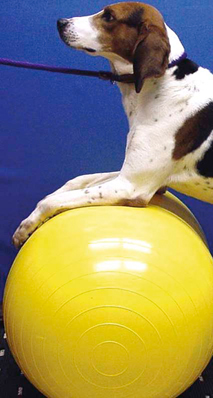
Joint Motion Exercises
Incline Walking
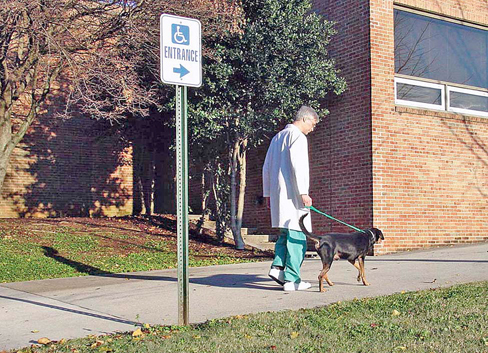
Figure 30-1 Leash walking up ramps or hills encourages muscle strengthening and cardiovascular endurance.
Joint Motion Considerations
Exercise Considerations
Stair Climbing
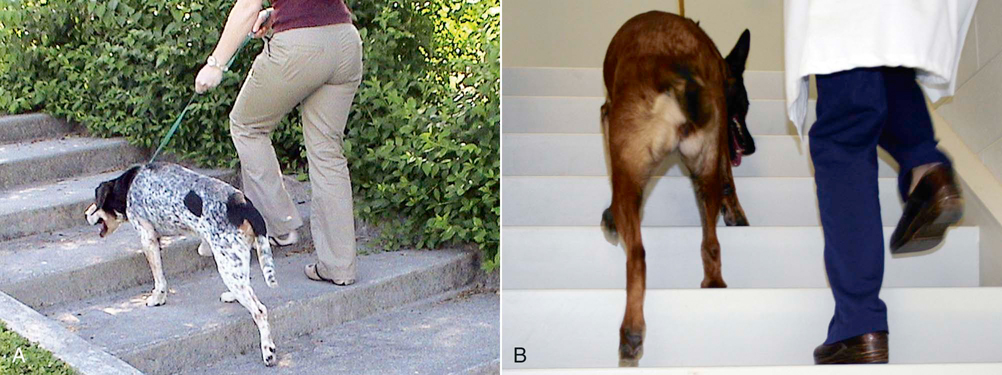
Figure 30-3 Stair climbing should begin on stairs with a gradual rise (A) and progress to steeper stairs (B). Care should be taken to be certain that the dog pushes symmetrically off of both rear limbs.
Joint Motion Considerations
Dancing and Wheelbarrowing
Joint Motion Considerations
Exercise Considerations
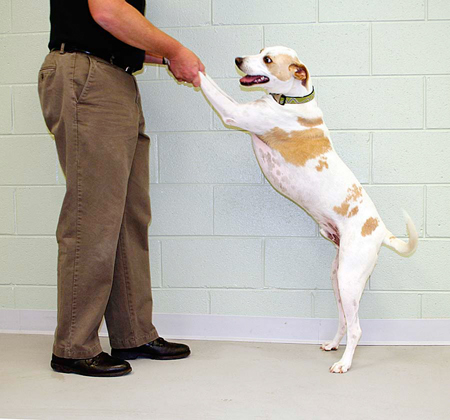
Figure 30-4 Dancing encourages weight bearing on the rear limbs. Muzzling may be necessary for some dogs before this exercise, particularly in dogs that do not like to have their feet touched or feel threatened by the therapist’s posture. The forelimbs are lifted off the ground, allowing the patient to bear weight only on the rear limbs.
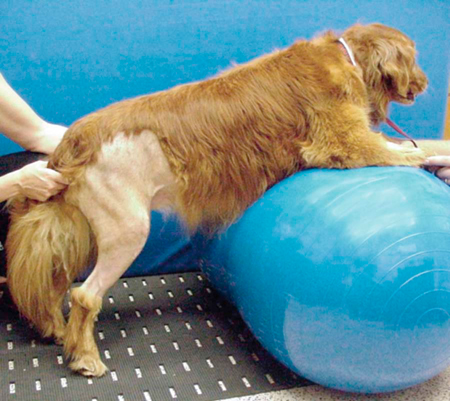
Figure 30-5 Dancing activities may also be accomplished with assistance of a physioroll or egg ball. The patient places their front limbs on the roll or ball and the therapist slowly rolls the ball toward or away from the patient forcing them to move their hindlimbs backward or forward.
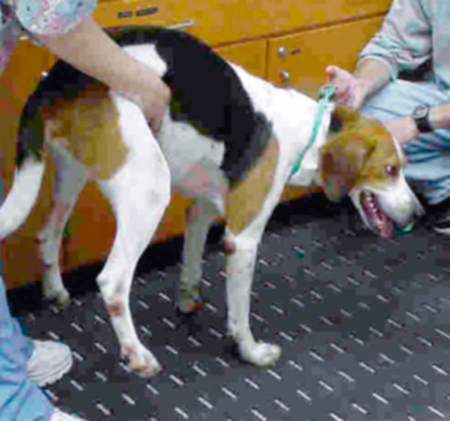
Figure 30-6 Wheelbarrowing encourages use of the forelimbs. The therapist supports the abdomen and lifts the rear limbs of the dog off the ground, and the dog is moved forward. The handler may wish to place a muzzle on the dog.
Sit-to-Stand Exercises
Exercise Considerations
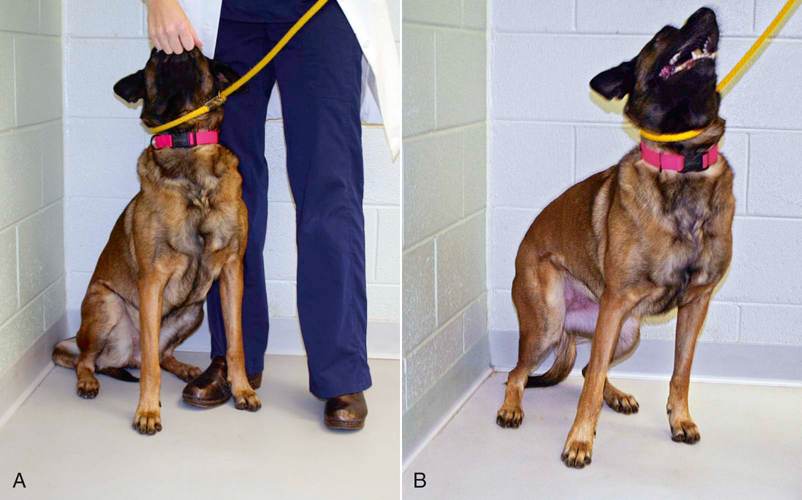
Figure 30-8 Sit-to-stand exercises. A, Note the symmetrical position of the dog in the sitting position. Placing the affected limb toward a wall will help the dog to sit in a square, symmetrical position. B, As the dog rises, it should push off equally with both rear limbs. Attention should be paid to sitting and standing straight, with no leaning to one side, and the joints of both rear limbs should be symmetrically flexed so that the dog sits squarely on its haunches.
Cavaletti Rails
Joint Motion Considerations
![]()
Stay updated, free articles. Join our Telegram channel

Full access? Get Clinical Tree


Therapeutic Exercises: Joint Motion, Strengthening, Endurance, and Speed Exercises
Only gold members can continue reading. Log In or Register to continue
